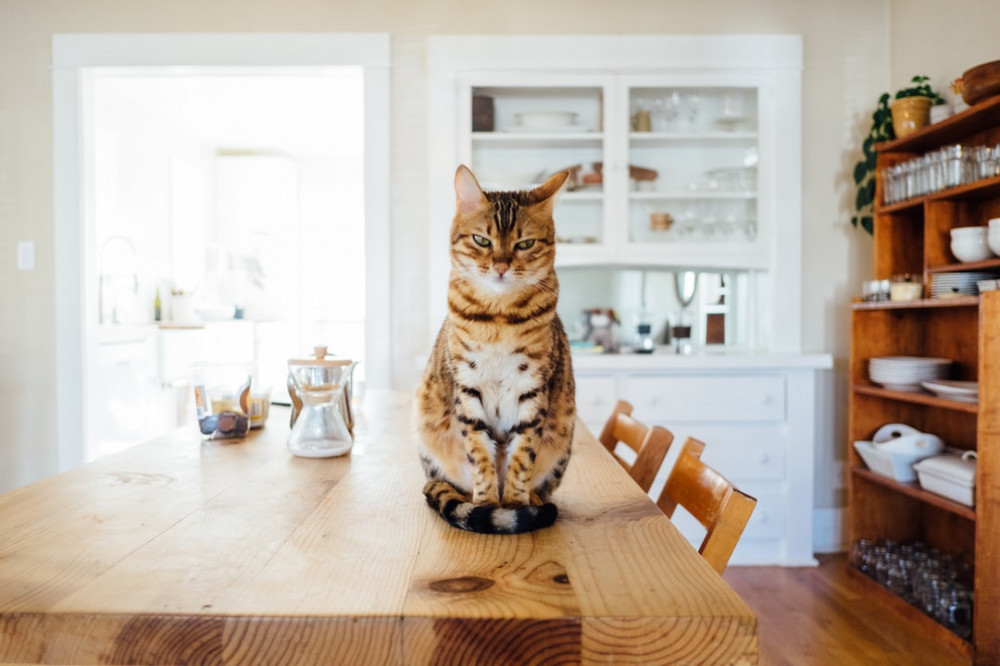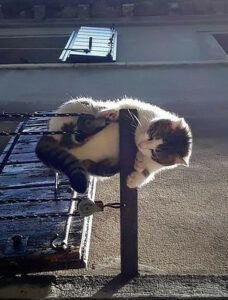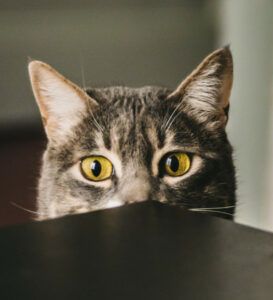
Hello, Cat Enthusiasts!
Today I’d like to talk about household hazards for cats. The following information is particularly important for first-time cat owners but also can be useful for experienced owners as the most common hazards often remain unnoticed.
Household Hazards for Cats
Common household hazards for cats include windows and doors, washer and dryer, electric cords, household chemicals and medications, garbage, small items, toxic plants, kitchen appliances and certain human foods.
Windows and Balconies
Cats can fall from open windows without pet screens (pet mesh) by accident or by pouncing at birds or insects. According to Wikipedia, cats get injuries (also called high-rise syndrome) by falling from a building, typically higher than two stories (7-9 m (23-30 ft)).
It’s not enough to have standard insect screens for windows. They’re flimsy and a cat can push them out of place, climb or tear through the screen and get outside or fall.
It’s better to use much sturdier cat-proof window screens which designed to keep cats inside as well as insects outside. You can DIY or purchase them.
If you have tilting (Tilt&Turn;) windows, please, be cautious! Cats often try to get outside through that narrow V-opening and can get trapped.
The more they try to get out, the more they get stuck, compressed under their own weight. If unsupervised, cats can get severe injuries, such as spinal damage, broken pelvis, internal bleeding, crushed internal organs, or even die very quickly.

In addition, it’s very difficult to remove them because it’s impossible to open the window without fully closing it first.
Don’t leave a cat in a room with a tilted window without supervision or use tilting window protection, such as protective grills for tilted windows (best for high-rise windows) or window guards for cats. If none of these is at hand, you can put rolled up towels into the gap on both sides to prevent a cat from getting stuck.
Dangers associated with balconies include risk of falling, extreme weather, risk of getting burned by a hot grill or getting stuck in a railing and risk of encountering dangerous insects.
Don’t leave your cat alone on a balcony. Use a cat harness and leash or build a cat-proof enclosure (catio).
Doors
Slamming doors are dangerous to cats as they can inflict an injury or amputation of a body part.
Cat owners tend to keep their interior doors open because cats love the freedom to get wherever they want in the house at any given moment and therefore dislike closed doors. Keeping doors open can cause slamming. And they often slam shut on a cat’s tail, paw, head, etc.
In addition, cats spend a lot of time in the doorways – sitting, standing, even sleeping – and can easily get hit by the door.
There is a variety of doorstoppers, automatic door closers and finger pinch guards available to solve the slamming doors problem.
Washer and Dryer
We all know that cats enjoy hiding in enclosed dark places and often climb into front loading washers and dryers. You can imagine what happens when people switch the machine while a cat is sleeping or hiding inside. Right, a deadly laundry.

Check and double check the machine every single time before shutting and running it. Just make it a habit and you’ll probably save your cat’s life one day.
Electric Cords
Cats, especially young ones, enjoy chewing on things. That’s fine but we don’t want our cats to chew on power cables and cords as it can cause a short circuit which can electrocute a cat and start a fire. Ingestion of wires is also dangerous as it causes damage to a cat’s gastrointestinal tract.
Cats can be trained to ignore cords but if you have a kitten, it’s better to hide the cords where possible and be extra vigilant as kittens often keep chewing while you’re away or sleeping.
There are many different types of cord protectors and cord management covers available. It also helps to cover cords with aluminum foil as a temporary measure and use furniture and carpets to hide them. Keep small cords like headphones away from a cat in a safe place when you don’t use them.
Cleaning Supplies and Home Insect Products
Virtually every household cleaning product is toxic to cats. Accidental inhaling or ingestion of toxic substances result in contact dermatitis, gastrointestinal, respiratory and nervous system damage, corrosive wounds or chemical burns depending on amount and toxicity of an element. Elements, particularly harmful to cats are:
- corrosive or caustic products
- alcohol-based products
- bleach
- acids
- oxide/hydroxide ingredients
- ammonia
- phenols
- benzalkonium chloride
Cats love monitoring and participating in household routines so the best way to avoid an accidental poisoning is keeping them out of the room while you are cleaning. Store your cleaning supplies in a safe place out of reach of a cat.
Home, lawn and garden insecticides and flea treatments for dogs are toxic to cats.
Lawn insecticides as well as other harmful chemicals and pathogens from outside can be brought in on shoes. Remove the shoes before entering a home (or wear shoe covers) to prevent contamination of surfaces, especially if you have carpets at home.
Some flea treatments for dogs and home flea treatments contain pyrethroids which are extremely toxic to cats. Never use a dog product on a cat and keep your cat in a different room when you apply pyrethroids-containing treatments.
Household Medications
Both prescribed and OTC (over-the-counter) human medications are toxic to cats. Cats have different physiology and drug metabolism than humans and other species. Human medications designed and tested only for people, so it’s important to keep them away from cats and other animals.
Never give a medication to a cat without first consulting with your veterinarian who can prescribe a correct form and dosage individually for your cat. Store your household medications out of reach of a cat.
Garbage
It’s only natural that the majority of kittens and some adult cats find it exciting to investigate the contents of a trash can. The trash can for cats is a lovely box filled with fantastic treasures which smell so interesting and produce so funny noises that cats just cannot stand it. They must check it out. In addition, humans refill that box with new toys every day making the trash can even more attractive to cats.
Bad news is that cats can find potentially harmful “toys” in a trash can, such as:
- spoiled food – a source of bacteria and moulds
- Styrofoam, plastic and paper can cause a partial or full blockage of a cat’s gastrointestinal system if ingested
- the eating of chicken and fish bones or bone fragments can result in choking, throat damage or blockage of the stomach and intestines
- cats can get cut on sharp edges of metal cans and glass
The best solution is to keep the garbage out of reach of a cat. For example, under the sink. It also helps to use a trash can with a covered lid and take the garbage outside frequently.
Small Items
Cats love playing with miscellaneous things that people put on tables, nightstands and counters and love knocking items off the surfaces.
Hair ties, jewelry, bobby pins, coins, desk items are potentially harmful to cats if swallowed. Sometimes small items pass through the gastrointestinal tract without complications. In other cases, such objects can block the intestines causing foreign body obstruction which require surgical treatment.

Long objects, such as yarn, thread, string, ribbon can cause a gastrointestinal blockage like a hairball or make a linear foreign body which can result in an intestinal perforation and peritonitis.
In addition, there can be other objects attached to strings, threads and ribbons. For example, a cat can swallow a balloon attached to a ribbon or a needle attached to a thread. In this case the foreign body must be removed surgically.
It’s best to keep your miscellaneous stuff off the floor and out of cats’ reach – in drawers or cat-proof containers.
Plants
Check out the ASPCA’s toxic and non-toxic plant list for more information.
Kitchen
Kitchen is a dangerous place for cats, especially when you’re cooking. It’s OK if your cat likes just sitting and monitoring your activity but it can be a problem if it wants to participate – jumps up the working surfaces and tries various food ingredients.
Cats can jump up onto the stove and get severe burns or even start a fire.
Kitchen counters and tables are cats’ favourite places. However, there can be harmful food ingredients, hot pots and sharp knives on the counter.
A cat can get hit by the door of a dishwasher or refrigerator (or even get trapped inside the refrigerator). The same is true for kitchen cabinets plus latter can contain something poisonous to cats.
It’s best to keep your cat in a different place when you’re cooking to avoid stress and accidents.
Human Foods
Cats have different nutritional needs than humans and require an individual well-balanced diet. If you have a young and healthy cat, small amounts (about 5 percent of your cat’s daily calorie intake) of lean cooked meat, fruits and vegetables from time to time won’t do any harm. However, keep in mind that there are human foods and ingredients that are dangerous to cats, such as:
- salty foods (e.g., bacon, potato chips)
- yeast dough
- caffeine-containing products (tea, coffee, energy drinks, etc.)
- cocoa products
- raw fish, meat and eggs
- raw potatoes
- citrus
- onions and garlic
- avocados
- grapes and raisins
- nuts
- dairy products
- high-fat foods
Keep these products, as well as bones and food scraps, out of cats’ reach.
Final Thoughts
This list of household hazards is not all-inclusive. Every home is full of hidden dangers for cats and it’s important to discover potentially dangerous areas before your cat gets into trouble.
Here’s a good exercise for cat owners: try to see familiar things from a cat’s perspective to find unsafe areas and take steps to prevent accidents from occurring. Repeat this exercise regularly to ensure your home is safe for your cat.
If you have something to add or wish to share your experience, please leave a comment.
Thank You For Reading!
